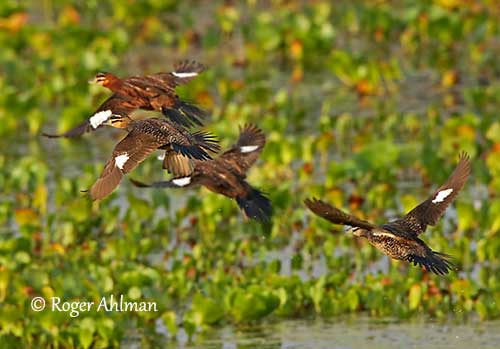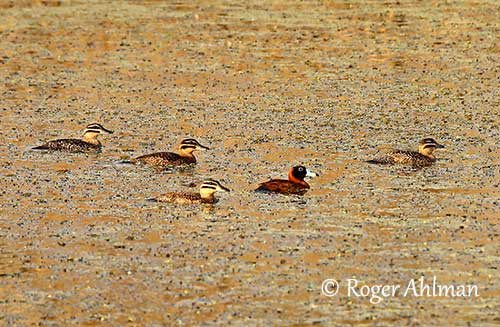
Fr : Erismature routoutou
Ang : Masked Duck
All : Maskenruderente
Esp : Malvasía Enmascarada
Ita : Gobbo mascherato
Nd : Maskerstekelstaart
Sd : svartmaskad kopparand
Photographers:
Roger Ahlman
Pbase Galleries Peru and Ecuador
Jean Michel Fenerole
Photos d’Oiseaux du monde
William Price
PBase-tereksandpiper & Flickr William Price
Text by Nicole Bouglouan
Sources :
HANDBOOK OF THE BIRDS OF THE WORLD vol 1 by Josep del Hoyo-Andrew Elliot-Jordi Sargatal - Lynx Edicions - ISBN: 8487334105
FIELD GUIDE TO THE BIRDS OF NORTH AMERICA - National Geographic Society -ISBN: 0792274512
A GUIDE TO THE BIRDS OF MEXICO AND NORTHERN CENTRAL AMERICA by Steve N. G. Howell, Sophie Webb - Oxford University Press - ISBN: 0198540124
A GUIDE TO THE BIRDS OF COLOMBIA by Steven L. Hilty and William L. Brown - Princeton University Press – ISBN 069108372X
BIRDS OF PERU by Thomas S. Schulenberg, Douglas F. Stotz, Daniel F. Lane, John P. O’Neill, Theodore A. Parker III – Princeton University Press 2007- ISBN: 978-0-691-13023-1
GUIDE DES CANARDS, DES OIES ET DES CYGNES – de Steve Madge - Delachaux et Niestlé - ISBN: 2603013769
Neotropical Birds – Cornell Lab of Ornithology
All About Birds (Cornell Lab of Ornithology)
South Dakota Birds and Birding – (Terry L. Sohl)
Wikipedia, the free encyclopaedia
What Bird-The ultimate Bird Guide (Mitchell Waite)
The Masked Duck in the United States by Paul A. Johnsgard and Dirk Hagemeyer
Peru Aves-Peru Birds - Masked Duck (Nomonyx dominicus)
Masked Duck
Nomonyx dominicus
Anseriformes Order – Anatidae Family
INTRODUCTION:
The Masked Duck is a very secretive duck that is uncommon throughout its wide range from Mexico to South America and Caribbean. It was formerly a member of the genus Oxyura, but it has now its own genus Nomonyx.
It is a small, stiff-tailed duck, usually found in a variety of freshwater bodies with marshy vegetation and heavy tree cover on the shores. It feeds mainly on plant material, but it also consumes aquatic invertebrates.
The Masked Duck is not globally threatened, but hunting and drainage of wetlands involve some decline of the population.
DESCRIPTION OF THE BIRD:
Biometrics:
Length: 30-36 cm
Wingspan: 43 cm
Weight: M: 360-450 g – F: 275-445 g
The Masked Duck adult male in breeding plumage has rufous-chestnut black-spotted plumage on flanks and upperparts. The wings and the stiff tail are blackish. On the upperwing, we can see a large, white patch, conspicuous in flight.
On the underparts, breast and belly are buffy-white. The axillaries are white.
On the head, a black face mask extends to the rear crown, but nape and neck are uniformly bright chestnut.
The bill is bright blue with black nail. The eyes are dark brown, surrounded by whitish eyering. Legs and webbed feet are grey-black.

The non-breeding male resembles female, but it has larger white wing patches. On the head, the pattern is less contrasted and the lower cheek stripe is broader.
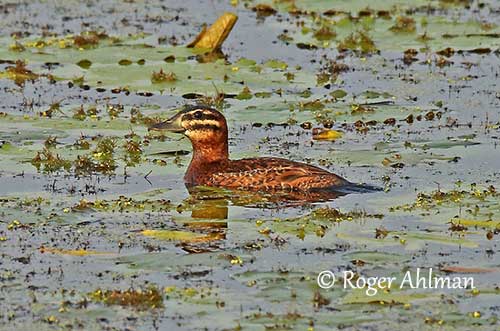
The adult female has rufous-brown plumage, heavily streaked dark brown, mainly on the upperparts. Wings and tail are blackish with smaller white wing patch. The buffy-white underparts are spotted and mottled dark brown. The axillaries are white.
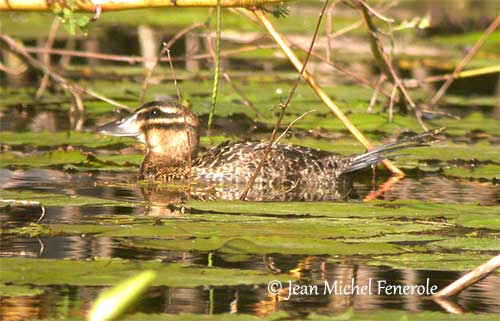
The non-breeding female lacks the rufous tones and becomes mostly sandy-buff.
The juvenile resembles female, but with more uniform underparts. The crown is darker and the upperparts show paler barring.
RANGE:
The Masked Duck is found from S USA (S Texas), Mexico and West Indies, S to NW Peru, and E of Andes to NE Argentina.
HABITAT:
The Masked Duck frequents marshy ponds with emergent vegetation such as rushes. It is often seen on small freshwater bodies and roadside ditches. It favours the waters surrounded by dense tree cover. In Venezuela, it can be seen in mangroves, swamps and ricefields.
This species is visible between 880 and 1500 metres of elevation according to the range.
CALLS AND SONGS: SOUNDS BY XENO-CANTO
The Masked Duck male gives repeated, throaty “kir-roo-kirroo-kiroo” during the displays, and softer “oo-oo-oo” similar to the cooing of a pigeon. The female produces a repeated hiss when disturbed, and clucking calls.
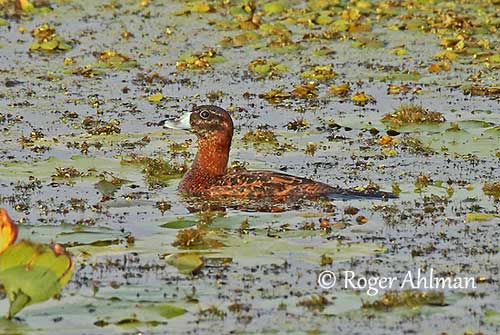
BEHAVIOUR IN THE WILD:
The Masked Duck feeds primarily on a variety of aquatic vegetation, taking mainly seeds, roots, tubers and parts of grasses and sedges. It also takes aquatic invertebrates such as insects and crustaceans.
It feeds by diving among Nymphaceae and other aquatic vegetation, usually in shallow water and during 20-30 seconds. It is rarely active by day, but it often emerges onto open water at night for feeding.
The Masked Duck is usually seen in pairs or in small groups of up to 20 or more, usually of its own species, but sometimes with the Ruddy Duck. It swims low in water or partially submerged with only head and neck above the surface. Very secretive, it often escapes by diving or swimming and pushing into the dense marshy vegetation in which it clambers like a rail. This species may colonize small and temporary bodies of water.
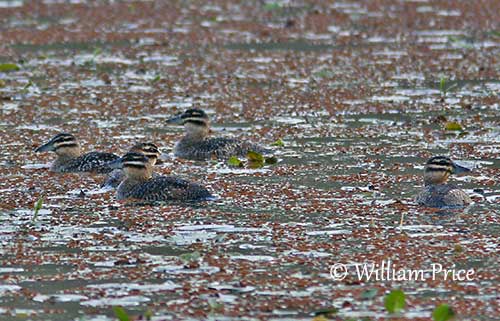
The Masked Duck male performs similar displays that the Ruddy Duck. It raises the stiff tail and lowers the bill onto its breast while giving soft calls “oo-oo-oo”. It also performs short rushes across the water surface. The neck appears inflated when the male approaches the female, while uttering its soft calls. The female remains motionless with the bill raised and the neck outstretched.
The Masked Duck is probably monogamous but with short-term pair bonds.
The Masked Duck is mostly sedentary but the species can be nomadic and dispersive, due, at least, to fluctuations of water levels. It may occur far beyond its breeding range, and is sometimes recorded in S Florida and Texas. It also reaches the coast of N Peru.
The Masked Duck has direct flight with rapid wingbeats. It takes-off from water nearly vertical, like the dabbling ducks. It does not need to run over the surface to take flight. When it returns, it often drops quickly into the dense cover.
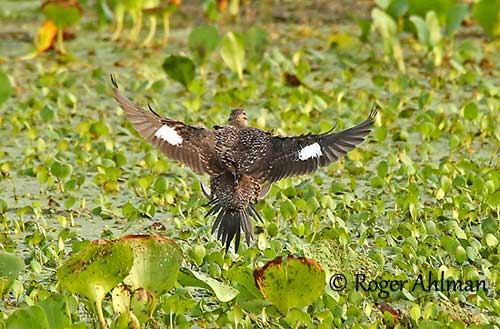
REPRODUCTION OF THIS SPECIES:
The Masked Duck probably breeds all year round throughout its range, with peak between June and October in Venezuela, and between November and May in West Indies.
It nests in single pairs, usually among marsh vegetation in shallow water. The female builds a woven bowl near water in dense vegetation, with reeds and other aquatic plants, and she adds a sparse lining of down. The nest is sometimes covered by vegetal dome.
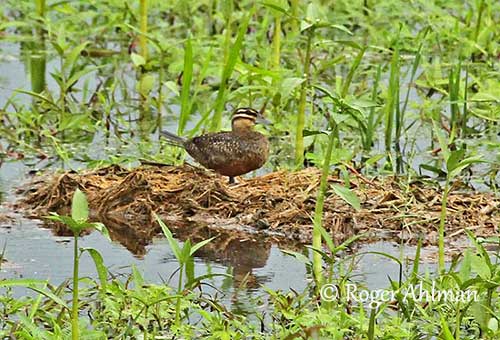
The female lays 3-6 creamy-white eggs, but larger clutches are the result of the laying of several females in the same nest. She incubates alone during four weeks. The chicks probably leave the nest very soon after hatching. They are very similar to the female. They are able to feed themselves, but they are accompanied by the female, and sometimes by both parents. They fledge about 45 days after hatching.
PROTECTION / THREATS / STATUS:
The Masked Duck is vulnerable to predation at nest by Southern Crested Caracara (C. plancus) and rats. It is threatened by over hunting and drainage of wetlands, and also by human pressure.
The population was estimated to number 50,000/499,999 individuals in 2008, but a previous estimate in 2005 was 25,000/100,000 individuals. However, the population is suspected to be declining.
But currently, the Masked Duck is evaluated as Least Concern.
